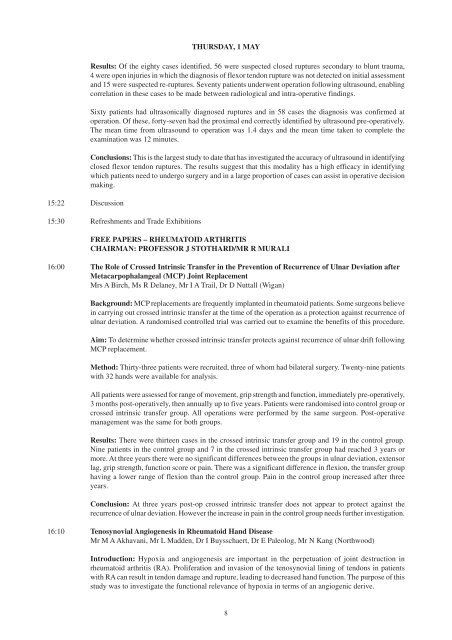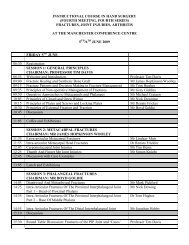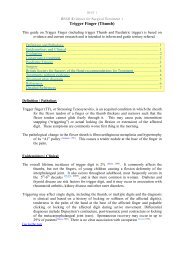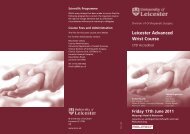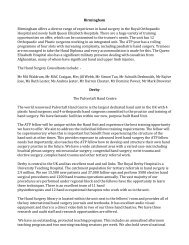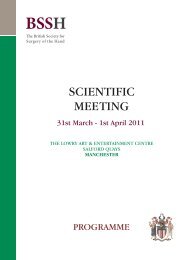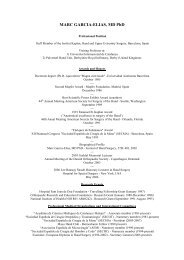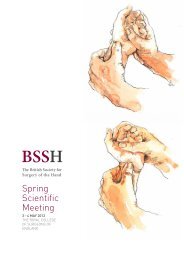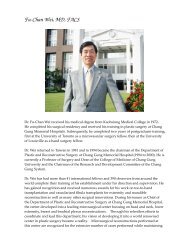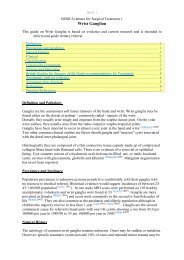here - The British Society for Surgery of the Hand
here - The British Society for Surgery of the Hand
here - The British Society for Surgery of the Hand
Create successful ePaper yourself
Turn your PDF publications into a flip-book with our unique Google optimized e-Paper software.
15:22 Discussion<br />
Results: Of <strong>the</strong> eighty cases identified, 56 were suspected closed ruptures secondary to blunt trauma,<br />
4 were open injuries in which <strong>the</strong> diagnosis <strong>of</strong> flexor tendon rupture was not detected on initial assessment<br />
and 15 were suspected re-ruptures. Seventy patients underwent operation following ultrasound, enabling<br />
correlation in <strong>the</strong>se cases to be made between radiological and intra-operative findings.<br />
Sixty patients had ultrasonically diagnosed ruptures and in 58 cases <strong>the</strong> diagnosis was confirmed at<br />
operation. Of <strong>the</strong>se, <strong>for</strong>ty-seven had <strong>the</strong> proximal end correctly identified by ultrasound pre-operatively.<br />
<strong>The</strong> mean time from ultrasound to operation was 1.4 days and <strong>the</strong> mean time taken to complete <strong>the</strong><br />
examination was 12 minutes.<br />
Conclusions: This is <strong>the</strong> largest study to date that has investigated <strong>the</strong> accuracy <strong>of</strong> ultrasound in identifying<br />
closed flexor tendon ruptures. <strong>The</strong> results suggest that this modality has a high efficacy in identifying<br />
which patients need to undergo surgery and in a large proportion <strong>of</strong> cases can assist in operative decision<br />
making.<br />
15:30 Refreshments and Trade Exhibitions<br />
THURSDAY, 1 MAY<br />
FREE PAPERS – RHEUMATOID ARTHRITIS<br />
CHAIRMAN: PROFESSOR J STOTHARD/MR R MURALI<br />
16:00 <strong>The</strong> Role <strong>of</strong> Crossed Intrinsic Transfer in <strong>the</strong> Prevention <strong>of</strong> Recurrence <strong>of</strong> Ulnar Deviation after<br />
Metacarpophalangeal (MCP) Joint Replacement<br />
Mrs A Birch, Ms R Delaney, Mr I A Trail, Dr D Nuttall (Wigan)<br />
Background: MCP replacements are frequently implanted in rheumatoid patients. Some surgeons believe<br />
in carrying out crossed intrinsic transfer at <strong>the</strong> time <strong>of</strong> <strong>the</strong> operation as a protection against recurrence <strong>of</strong><br />
ulnar deviation. A randomised controlled trial was carried out to examine <strong>the</strong> benefits <strong>of</strong> this procedure.<br />
Aim: To determine whe<strong>the</strong>r crossed intrinsic transfer protects against recurrence <strong>of</strong> ulnar drift following<br />
MCP replacement.<br />
Method: Thirty-three patients were recruited, three <strong>of</strong> whom had bilateral surgery. Twenty-nine patients<br />
with 32 hands were available <strong>for</strong> analysis.<br />
All patients were assessed <strong>for</strong> range <strong>of</strong> movement, grip strength and function, immediately pre-operatively,<br />
3 months post-operatively, <strong>the</strong>n annually up to five years. Patients were randomised into control group or<br />
crossed intrinsic transfer group. All operations were per<strong>for</strong>med by <strong>the</strong> same surgeon. Post-operative<br />
management was <strong>the</strong> same <strong>for</strong> both groups.<br />
Results: T<strong>here</strong> were thirteen cases in <strong>the</strong> crossed intrinsic transfer group and 19 in <strong>the</strong> control group.<br />
Nine patients in <strong>the</strong> control group and 7 in <strong>the</strong> crossed intrinsic transfer group had reached 3 years or<br />
more. At three years t<strong>here</strong> were no significant differences between <strong>the</strong> groups in ulnar deviation, extensor<br />
lag, grip strength, function score or pain. T<strong>here</strong> was a significant difference in flexion, <strong>the</strong> transfer group<br />
having a lower range <strong>of</strong> flexion than <strong>the</strong> control group. Pain in <strong>the</strong> control group increased after three<br />
years.<br />
Conclusion: At three years post-op crossed intrinsic transfer does not appear to protect against <strong>the</strong><br />
recurrence <strong>of</strong> ulnar deviation. However <strong>the</strong> increase in pain in <strong>the</strong> control group needs fur<strong>the</strong>r investigation.<br />
16:10 Tenosynovial Angiogenesis in Rheumatoid <strong>Hand</strong> Disease<br />
Mr M A Akhavani, Mr L Madden, Dr I Buysschaert, Dr E Paleolog, Mr N Kang (Northwood)<br />
Introduction: Hypoxia and angiogenesis are important in <strong>the</strong> perpetuation <strong>of</strong> joint destruction in<br />
rheumatoid arthritis (RA). Proliferation and invasion <strong>of</strong> <strong>the</strong> tenosynovial lining <strong>of</strong> tendons in patients<br />
with RA can result in tendon damage and rupture, leading to decreased hand function. <strong>The</strong> purpose <strong>of</strong> this<br />
study was to investigate <strong>the</strong> functional relevance <strong>of</strong> hypoxia in terms <strong>of</strong> an angiogenic derive.<br />
8


